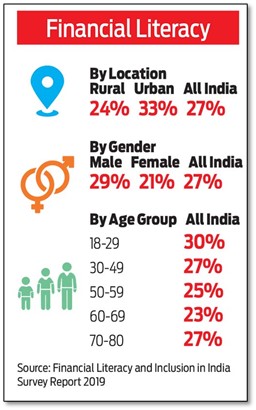Wednesday, 28th July 2021
Assam-Mizoram Border Dispute
In News: The recent violent clashes between Assam and Mizoram government authorities at Cachar-Kolasib district border resulted in death of at least 6 Assam policemen and left over 50 individuals injured. This event signals the re-emergence of long-unresolved Assam-Mizoram border dispute.
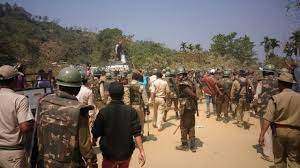
About the news
- A team of around 200 Assam Police led by the IGP, Assam Police, and the DC, SP and DFO of Cachar travelled to the Vairengte (Mizoram).
- While Assam claims that the state authorities had moved to “resolve matters”, Mizoram has said they “forced their way in”, overrunning security posts.
- Assam claims Mizoram began constructing a road towards Rengti Basti in Assam, destroying the Inner Line Reserve Forest in Lailapur area.
- Simultaneously, the Mizoram side also set up a new armed camp on a hillock next to the camp of the neutral force, CRPF, in the same vicinity.
The Assam-Mizoram Boundary
- During the British rule, the state of Assam included present-day Nagaland, Arunachal Pradesh, Meghalaya, and Mizoram each of which became separate states later.
- Presently, there is 170km inter-state border that separates Assam and Mizoram, with the three Assam districts of Cachar, Hailakandi and Karimganj sharing a border with Kolasib, Mamit and Aizawl districts of Mizoram.
- Formerly known as Lushai Hills, Mizoram is located on the southern fringes of Northeast India.
The Unresolved Conflict
- The dispute between Assam and Mizoram stems from a notification of 1875 that differentiated Lushai Hills from the plains of Cachar, and another notification of 1933.
- The state of Mizoram does not follow the notification of 1933, since the boundary was demarcated without the consultation of Mizo chiefs.
- The two states signed an agreement that status quo be maintained and no-man’s land be set up at the boundary.
- The dispute took aggressive and violent turn after the formation of Mizoram state in 1987.
- Mizoram claims that the imaginary state boundary line has been pushed farther and farther south of the Inner Line of 1875, depriving the Mizos of the gentle slopes and flat lands for the convenience of outside settlers.
Sources:
- Explained: How did the 150-year-old Assam-Mizoram dispute get so violent now?
- Assam-Mizoram border row flares again
- Explained: Assam-Mizoram, and the other boundary disputes in the northeast
- Assam-Mizoram border dispute: Baggage of the past
- All about Assam-Mizoram border dispute, which dates back 50 yrs & still remains unresolved
United Nation’s Global Survey on Digital and Sustainable Trade Facilitation 2021
In News: India has scored 90.32% in United Nation’s Economic and Social Commission for Asia Pacific's (UNESCAP) latest Global Survey on Digital and Sustainable Trade Facilitation which is a remarkable jump from 78.49% in 2019.
About the news
- The Survey for 2021 has pointed out India’s improvement in the scores on all five key indicators- transparency, formalities, institutional arrangement and cooperation, paperless trade, and cross-border paperless trade.
- Transparency:100% in 2021 (from 93.33% in 2019)
- Formalities: 95.83% in 2021 (from 87.5% in 2019)
- Institutional Arrangement and Cooperation: 88.89% in 2021 (from 66.67% in 2019)
- Paperless Trade: 96.3% in 2021 (from 81.48% in 2019)
- Cross-Border Paperless Trade: 66.67% in 2021 (from 55.56% in 2019)
Global Comparison
- The Survey notes that India is the best performing country when compared to South and South-West Asia region (63.12%) and Asia Pacific region (65.85%).
- The overall score of India has also been found to be greater than many OECD countries.
- India has achieved a 100% score for the Transparency index and 66% in the “Women in trade” component.
Cause of Improvement
- The CBIC (Central Board of Indirect Taxes and Customs) has been at forefront of path breaking reforms under the umbrella of ‘Turant’Customs to usher in a Faceless, Paperless and Contactless Customs by way of a series of reforms.
- During the Covid-19 pandemic, Customs formations worked to expedite imports such as oxygen-related equipment, life-saving medicines, vaccines, etc.
- A dedicated single window COVID-19 24*7 helpdesk for EXIM trade was created on the CBIC website to facilitate quick resolution of issue(s) faced by importers.
About the Survey
- The Global Survey on Digital and Sustainable Trade Facilitation covers WTO trade facilitation measures and is conducted every two years.
- The 58 measures for trade facilitation include publications of existing import-export rules on the internet, risk management, advance ruling on tariff classification, pre-arrival processing, independent appeal mechanism, expedited shipments and automated customs system, etc.
- The survey evaluates 143 economies across the world.
- A higher score for a country helps businesses in their investment decisions.
Source:
Secrecy of Vote
In News: The Supreme Court of India recently held that in any election, be it to Parliament or State legislature, the maintenance of secrecy of voting is “a must”.
What Is a Secret Vote?
- The secret vote/secret ballot is a voting method in which a voter’s choices in an election are anonymous.
- It aims for forestalling attempts to influence the voter by intimidation, blackmailing, and potential vote-buying.
- The system is one means of achieving the goal of political privacy.
Highlights of the Recent Judgement
- Part of Fundamental Right: The secrecy is a part of the fundamental right of freedom of expression.
- The confidentiality of choice strengthened democracy.
- Part of Basic Structure: Democracy and free elections were part of the basic structure of the Constitution.
- Booth Capturing: Booth capturing or bogus voting should be dealt with iron hands, because it ultimately affects the rule of law and democracy.
- The SC reiterated its 2013 judgement in the People's Union for Civil Liberties case. Its two key components are:
- Right to vote also includes a right not to vote i.e right to reject (implies that a voter while voting has every right not to opt for any of the candidates during an election).
- Right to secrecy is an integral part of a free and fair election (Right to secrecy is a central right of an elector to cast his vote without fearof reprisal, duress or coercion as per Article 21 of the Indian Constitution).
- Unlawful Assembly: Once the unlawful assembly is established in prosecution for the common object, each member of the unlawful assembly is guilty of the offence of rioting.
- The use of the force, even though it be the slightest possible character by any one member of the assembly, once established as unlawful constitutes rioting.
- It is not necessary that force or violence must be by all but the liability accrues to all the members of the unlawful assembly.
Sources:
Amendment to the Indian Forest Act
In News
The ministry of environment, forest, and climate change (MoEFCC) released the second expression of interest (EOI) to amend the Indian Forest Act, 1927 recently.

About the News
- The objective of this exercise is to prepare a draft of the comprehensive amendment of Indian Forest Act, 1927 in consultation with State Governments/UT Administrations, Central Government ministries and other stakeholders.
- The EOI states that the Centre is presently undertaking a review of legislation implemented by different ministries to bring them at pace with contemporary needs.
What is the Proposal in the EOI?
- The Indian Forest Act (IFA), 1927 is one of the major Acts which is administered in the forestry sector. Brought in India’s pre-independence period, the 94-year-old law was meant to consolidate all the then laws relating to forests, the transit of forest produce and the duty leviable on timber and other forest produce.
- The last such exercise on IFA started in 2017 and the first draft was placed in public domain. Based on comments received, it has been considered that a more comprehensive and pragmatic amendment of the Indian Forest Act, 1927 may be examined.
Why does the government intend to make these proposed amendments?
- To meet the contemporary needs: The process aims to examine and incorporate pragmatic legal provisions already made in state forest laws and state amendments in the Indian Forest Act so that all states benefit similarly.
- Expedite legal processes: The exercise focuses on decriminalising relatively minor violations of law, expeditious resolution through compounding relatively small offences, reducing compliance burden on citizens, rationalisation of penalties, de-clogging criminal justice system, expanding and improving of the use efficiently of resources, and promoting people participation and ease of doing business.
- Economic growth of Forest Sector: The amendment may encompass, provision of graded penalty, removing difficulties in trade and transit of forest products across States, or across national borders in order to encourage forest sector economic growth in the country.
- Increasing Afforestation: The proposed amendment also aims at encouraging specially non-government actors/ private sector/ civil society/ individuals to take up afforestation/tree planting and/or to develop/manage private forest on non-forest lands on their own.
- Heedful amendment: The idea behind hiring a consultant is to take utmost care in proposing amendments to this important act and avoid controversies, as the previous attempts at amendment to the Forest Act had faced severe opposition from the stakeholders.
What are the Concerns regarding the EOI?
- Limiting the role of Public Servants: Concerns are being raised regarding outsourcing the task of drafting a law to private consultancies. The EOI thus happens to limit the role of public servants to merely commenting on drafts prepared by private entities.
- Affecting Federalism: Forests are in the concurrent list and hence both states and the Centre have the right to enact law on the subject. Through the Forest (Conservation) Act 1980, Centre assumed only one specific role of conservation of forest land. The responsibilities de facto rested with the states, leading to enactment of state-specific Forest Acts.
- So the proposed amendments seems to be an attempt by the Centre to amend a law that is within the domain of the states. If effected, they will repeal the Forest Acts of all states that don’t follow the Indian Forest Act 1927.
- Contentious Provisions: Some of the provisions that can be potentially misused are
- “Reducing compliance burden on citizens”: This can lead lowering the need to submit compliance reports by the forest-land users’, which may even include mining companies’ and hydropower projects.
- “Expanding and improving” the efficient use of resources: It can lead to opening up forest land for various uses, leading to more deforestation.
- Critical ecological factors missing: Climate change, arresting biodiversity loss, conserving forests and protecting the rights of forest-dwellers don’t feature in the EOI.
- Arbitrary and discriminatory criteria of bid invitation: The criteria exclude organisations that have represented environmental groups and forest-dwelling communities, and work with forest-dependent communities to protect forests and wildlife. Any private agency cannot be best placed to understand the intricacies of the Indian Forest Act 1927.
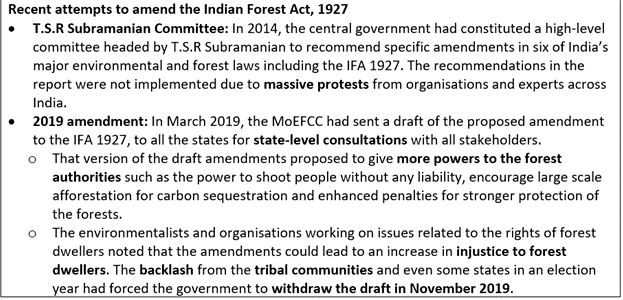
Way Forward
- Stakeholders’ engagement in drafting: There is need to engage, the people connected with the local situation in the forests and who will be most impacted by changes in the law, like the forest dwelling communities, state governments, environmentalists etc., in drafting of the amendment. The involvement of private organisations may lead to conflict of interests.
- Address the reasons of backlash: The government needs to address the root cause of the backlash that the amendments to the IFA, 1927 happen to face in every attempt. The concerns of lives, identities and livelihoods of the people who will be potentially impacted and the rising ecological concerns, need to be addressed.
Question: Discuss the objectives that the government seeks to achieve through the Expression of Interest (EOI) to amend the Indian Forest Act, 1927. What are the concerns related to the EOI?
Sources:
This Day in History- Non-Cooperation Movement
On July 28, 1921, the Congress decided to boycott the upcoming visit of the Prince of Wales in November as part of the Non- Cooperation Movement. The visit of the Prince of Wales in November 1921 was marked with demonstrations, hartals and political meetings. The programme of "non-violent non-cooperation" included the boycott of councils, courts and schools, set up by the British and of all foreign cloth. The Non-cooperation movement was organised to induce the British government to grant self-government, or swaraj, to India.

Source:
Image Source:
Image of the Day -Dholavira
This is the image of the ruins of Harappan city Dholavira in Rann of Kutch, Gujarat, which has found a place in UNESCO’s World Heritage list, making it the 40th world heritage property in India. It is one of the very few well-preserved urban settlements in south Asia dating from the 3rd to mid-2nd millennium BCE. The Harappan-era metropolis is the fifth largest archaeological site of the Indus Valley Civilisation.
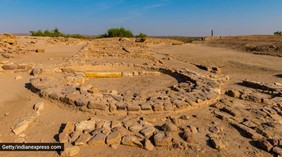
Source:
Exercise Cutlass Express
- Context: Indian Naval Ship Talwar recently participated in Exercise Cutlass Express.
- It is an annual maritime exercise conducted to promote national and regional maritime security in East Africa and the Western Indian Ocean.
- The 2021 edition of the exercise involves participation of 12 Eastern African countries, US, UK, India, and various international organizations like International Maritime Organization (IMO), United Nations Office on Drugs and Crime (UNODC), Interpol, European Union Naval Force (EUNAVFOR), Critical Maritime Routes Indian Ocean (CRIMARIO) and EUCAP Somalia.
- The exercise focusses on East Africa’s coastal regions and is designed to assess and improve combined maritime law enforcement capacity, promote national and regional security, and increase interoperability between the regional navies.
- India’s Information Fusion Centre – Indian Ocean Region (IFC-IOR) would contribute in achieving the same.

Source:
Image Source:
Garib Nawaz Employment Scheme
- Context: Maulana Azad Education Foundation, an autonomous body under the aegis of Ministry of Minority Affairs has implemented Garib Nawaz Employment Scheme.
- The main aim of this scheme is to provide short term job-oriented skill development courses to minorities’ youthto enable them for skill-based employment.
- This scheme is implemented as per common norms of the Ministry of Skill Development & Entrepreneurship (MSD&E) and it ismandated to place minimum 70% trainees out of total trained trainees.
- A total Number of 371 training centers are opened across the country.

Source:
Thane Creek Flamingo Sanctuary
- Context: The Mumbai Metropolitan Region is likely to get its first Ramsar site at the Thane Creek Flamingo Sanctuary (TCFS).
- It will be the first such site in Mumbai Metropolitan Region and third in the Maharashtra to be designated as Wetlands of International Importance.
- Surrounded by highly urbanized areas, this region is home to many mangrove species and marine flora-fauna.
- A Ramsar site is a wetland area designated to be of international importance under the Ramsar Convention, an intergovernmental environmental treaty that provides the framework for national action and international cooperation for the conservation and wise use of wetlands and their resources.
- It is Maharashtra’s second marine sanctuary after the Malvan sanctuary.
- It is recognized as an “Important Bird Area” by the Bombay Natural History Society.
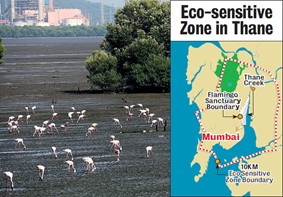
Source:
- Thane Creek Flamingo Sanctuary proposed as MMR’s Ramsar site
- Mangrove cell tables proposal to name flamingo sanctuary in Thane creek as ‘Ramsar site’
- Centre notifies 48.32 sq km around TCFS as eco sensitive zone
- Thane Creek Flamingo Sanctuary
Image source:
Kandla SEZ
- Context: Kandla SEZ (KASEZ) has been awarded Indian Green Building Council (IGBC) Platinum Rating.
- KASEZ is the First Green SEZ to achieve the IGBC Green Cities Platinum Rating for Existing Cities.
- The rating has been awarded for ‘Green master planning, policy initiatives and implementation of green infrastructure’ by Confederation of Indian Industries (CII’s) IGBC.
- IGBC, part of CII was formed in 2001 to enable a sustainable built environment for all and facilitate India to be one of the global leaders in the sustainable built environment by 2025.
- The efforts of KASEZ team were applauded especially noting the fact that this was accomplished in Bhuj region where water conservation and afforestation are critical interventions.

Source:
- Kandla becomes first Green SEZ;IGBC Green Platinum rating awarded to Kandla SEZ
- Confederation of Indian Industry
Image source:
Needed: an anti-trafficking law
Essence: In light of increase in the trafficking of children, persons, etc, the article talks about the government’s proposal of Trafficking in Persons (Prevention, Care and Rehabilitation) Bill, 2021. The bill aims to tackle all aspects of trafficking including social-economic causes of the crime, punishment to the traffickers and protection and rehabilitation of survivors. Covid-19 pandemic has deteriorated the condition with the ensuing lockdown, loss of family livelihood and closure of schools.
Human trafficking propels several other crimes like creating a parallel black economy which fuels child labor, child marriages, prostitution, bonded labor, forced beggary, drug-related crimes, corruption, terrorism, and illegal business.
Why you should read this article?
- To understand the linkage between trafficking of persons and other crimes
- To understand the various dimensions of the crime and proposed government bill
Source:
ESG- a value ecosystem for corporates
Essence- Crisil’s ESG (Environmental, Social and Governance) redefines corporate India’s approach to risk management for sustainable value creation. According to several reports, a strong ESG proposition translates into superior business performance, better credit ratings and higher financial returns. This will create value for corporates and their stakeholders in many ways by expanding existing markets. As the corporates don’t just function in a vacuum, there is a compelling need to evaluate their sustainable, responsible, and ethical practices along with their financial metrics. Companies have reached a tipping point wherein the Covid-19 is a wake-up call for building risk-resilient businesses.
Why should you read this article?
- To get an overview for corporate India’s approach to risk management for sustainable value creation.
- To understand how ESG will create value for corporates and their stakeholders?
Source:
Ela Bhat: Role model for woman empowerment
Contribution of Ela Bhatt:
- She is a ‘gentle revolutionary’ and a pioneer in women’s empowerment and grassroots development.
- She believed that poverty will never be removed without participation of women.
- She followed Gandhianism to the core, believing that self- reliance is the key to eradicating poverty.
- She is the founder of the more than 1 million-strong Self-Employed Women’s Association (SEWA) in India.
- Her successful leadership of SEWA won her national and international recognition and pull many women out of poverty
Values upheld by her:
- Leadership, Compassion, Selflessness, Innovation, Altruism
Source:
Share the article
Get Latest Updates on Offers, Event dates, and free Mentorship sessions.

Get in touch with our Expert Academic Counsellors 👋
FAQs
UPSC Daily Current Affairs focuses on learning current events on a daily basis. An aspirant needs to study regular and updated information about current events, news, and relevant topics that are important for UPSC aspirants. It covers national and international affairs, government policies, socio-economic issues, science and technology advancements, and more.
UPSC Daily Current Affairs provides aspirants with a concise and comprehensive overview of the latest happenings and developments across various fields. It helps aspirants stay updated with current affairs and provides them with valuable insights and analysis, which are essential for answering questions in the UPSC examinations. It enhances their knowledge, analytical skills, and ability to connect current affairs with the UPSC syllabus.
UPSC Daily Current Affairs covers a wide range of topics, including politics, economics, science and technology, environment, social issues, governance, international relations, and more. It offers news summaries, in-depth analyses, editorials, opinion pieces, and relevant study materials. It also provides practice questions and quizzes to help aspirants test their understanding of current affairs.
Edukemy's UPSC Daily Current Affairs can be accessed through:
- UPSC Daily Current Affairs can be accessed through Current Affairs tab at the top of the Main Page of Edukemy.
- Edukemy Mobile app: The Daily Current Affairs can also be access through Edukemy Mobile App.
- Social media: Follow Edukemy’s official social media accounts or pages that provide UPSC Daily Current Affairs updates, including Facebook, Twitter, or Telegram channels.

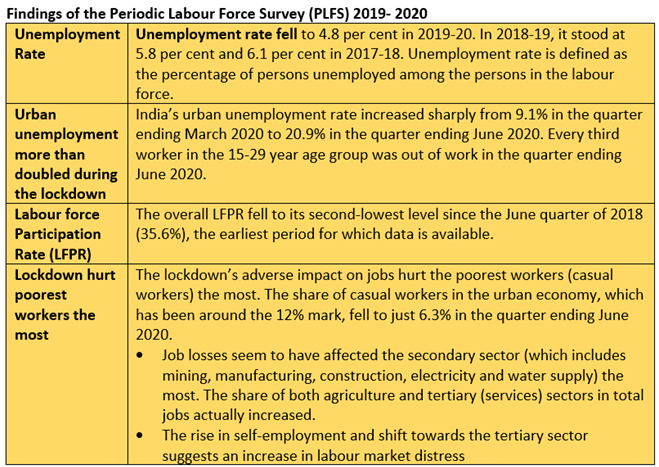
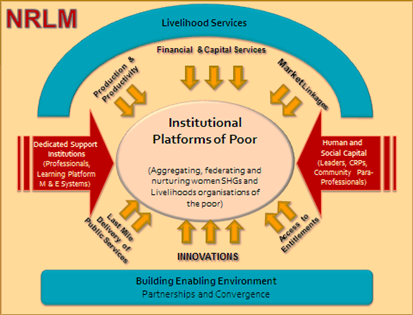
![Production-linked Incentive (PLI) Scheme for Specialty Steel • Digital Rupee • Renewable Energy Certificate (REC) Mechanism • This Day in History - Bal Gangadhar Tilak • Image of the Day – King Cobra • Project 75 (India) [P-75(I)] • Harela Festival • Avian Flu/ H5N1 • Expanding India’s foreign policy canvas – Hindustan Times • Bangladesh's Microfinance: Case study for reducing poverty](https://edukemyprodstorage.blob.core.windows.net/edukemy-v2-assets-public/newsletter-images/1627053778blobid1627053773170.jpg/6qOdfWHokMxecfCInlsNiohdzUmiiR170zseon9s.jpg)
